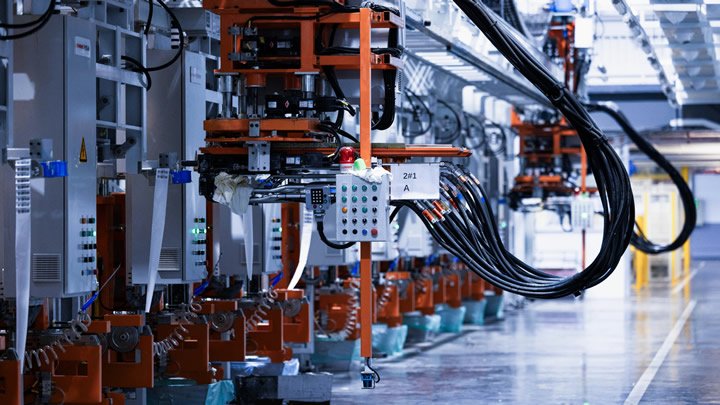
The industrial automation landscape has rapidly evolved in recent years, driven by growing demands for increased productivity, uptime, and faster output. To remain competitive, manufacturers must accelerate operations, reduce downtime, and adopt cutting-edge technologies that optimize every facet of the factory floor. This shift has propelled the need for smarter automation systems, from advanced sensors to robotics and cloud connectivity. In this article, we explore how the industrial automation sector is transforming, highlighting key trends and offering insights on how manufacturers can stay ahead.

Robotics: Transforming Manufacturing Through Precision and Efficiency
In modern manufacturing, robots have become indispensable, improving operational efficiency by performing repetitive tasks with high precision and consistency. These machines are not just improving productivity; they are also enhancing safety in hazardous environments by taking on dangerous jobs that would otherwise put human workers at risk.
Robotic systems have made significant strides in terms of flexibility. Today, robots can collaborate with human workers in “cobots” setups, which is helping to address labor shortages in manufacturing industries. With automation handling routine tasks, skilled labor can be re-deployed to higher-value roles, thus optimizing resource allocation. Importantly, robots still require maintenance and oversight, meaning human workers remain an integral part of the equation.
Robotic cells, which combine robots with various tools in a controlled environment, have also become a key asset. These cells enable manufacturers to achieve higher precision and repeatability in tasks such as welding, assembly, and material handling. The ability to trace errors back to specific machines, times, or production lots helps identify issues quickly, minimizing downtime and improving process efficiency.
Leading suppliers like Eaton are advancing robotic cells by providing intelligent power management systems, which offer predictive maintenance and real-time diagnostics to ensure operational reliability. These innovations significantly reduce unplanned downtime and improve overall safety on the shop floor.
The Role of Advanced Sensing in Smart Automation
As industrial automation becomes more sophisticated, the role of sensors has become increasingly crucial. Technologies such as LiDAR, infrared, optical, and ultrasonic sensors are enabling manufacturers to capture real-time data with unparalleled accuracy. These sensors, integrated with edge computing and cloud connectivity, give manufacturers the ability to monitor performance, detect inefficiencies, and make real-time adjustments to improve productivity.
In addition to performance monitoring, safety sensing technologies are playing a pivotal role in modern automation systems. Devices such as light curtains, emergency stops, and safe motion control systems help prevent accidents by providing warnings and stopping machinery if workers come too close to hazardous areas. These safety measures are integral to creating a safe working environment while maintaining efficiency.
For instance, companies like SICK are developing advanced sensor technologies that enhance production-line traceability. Their vision systems and smart sensors are particularly useful in high-speed environments, enabling manufacturers to monitor and adjust their processes in real-time.
Key Trends Shaping the Future of Industrial Automation
As technology continues to evolve, several key trends are reshaping the industrial automation landscape:
- Edge Computing: Artificial intelligence (AI) is moving closer to the source of data, processing information at the point of capture. This reduces the delays associated with sending data to centralized control units, enabling faster and more efficient decision-making.
- Wireless Connectivity: The industrial Internet of Things (IoT) is transforming the way machines communicate. Advances in wireless communication protocols like PROFINET and Modbus, as well as the emergence of Single Pair Ethernet (SPE), are streamlining the way devices communicate, making systems more flexible and reducing complexity.
- Safety-Integrated Automation: Manufacturers are increasingly adopting safety-integrated automation systems that combine both operational and safety features in real time. This integration ensures rapid scaling without compromising the safety of workers.
- High-Mix, Low-Volume Manufacturing: With the rise of modular, flexible automation systems, manufacturers can now produce custom configurations efficiently. This shift has revived the concept of high-mix, low-volume manufacturing, allowing for high-quality customization without the need for a specialized workforce.
- Digital Twins: Digital twin technology, which combines simulation-driven design with machine learning, is revolutionizing how manufacturers optimize their operations. By simulating real-world conditions, engineers can refine designs before production and continuously optimize systems during their lifecycle.
Practical Applications and Solutions
DigiKey has been at the forefront of providing industrial automation solutions that help manufacturers implement these emerging trends. By offering a wide range of advanced sensors, robotics, and connectivity solutions, DigiKey helps engineers and manufacturers find the tools they need to automate smarter, faster, and safer.
For example, in distribution centers, digital twin technology helps optimize workflows and minimize bottlenecks. By simulating the movement of goods and assessing packaging designs, DigiKey is able to streamline the supply chain, offering real-time insights into operational performance.
Conclusion: Adapting to the Future of Industrial Automation
The future of industrial automation is increasingly reliant on smarter technologies that enhance efficiency, safety, and scalability. From robotics and advanced sensing to wireless connectivity and AI-powered systems, the shift towards smarter manufacturing is well underway.
Manufacturers must stay ahead of the curve by embracing these technological advancements and integrating them into their operations. With the right automation systems in place, manufacturers can boost productivity, reduce costs, and maintain safety standards, all while remaining competitive in a rapidly evolving market.
For more industrial automation information, resources, and products, visit DigiKey Automation.